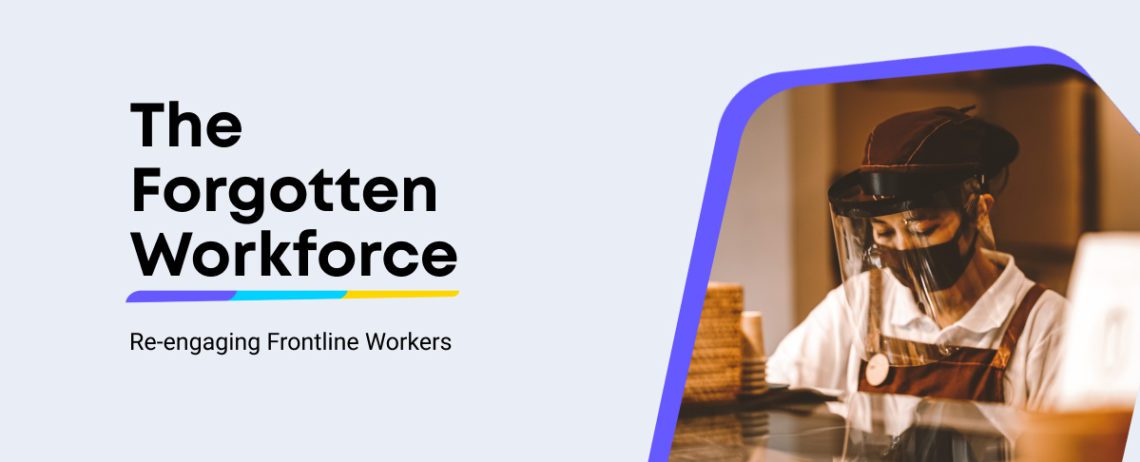The forgotten workforce: How to re-engage frontline workers
Ask The Experts | Feedback From The Field | By | 28 Jun 2021 | 4 minute read

Frontline workers are often left behind when it comes to new technology so, as the world of work becomes more distributed, how can tech help your workers without a desk keep up?
The coronavirus pandemic and lockdowns have clearly shown that office workers can remain productive when working away from a home office. Communication and collaboration suites came to their rescue, but unfortunately, these tools are often geared more to people sitting at a desk and less to those who get out and about.
Who are deskless workers?
Put simply, they’re anyone who doesn’t sit at a desk all day to do their job. They often spend their day on their feet – perhaps onsite with customers, out on the road or working on the retail, warehouse or factory floor.
Many deskless workers don’t have the option of working from home during the pandemic, instead they soldier on to keep businesses and the entire economy ticking along. They are the unsung heroes and often forgotten during talk of ‘working from home’ becoming an ongoing part of the fabric of society.
Why is it important to keep deskless workers engaged?
Deskless workers are the backbone of many organisations, now more than ever, so it is vital that they feel engaged and valuable members of the team. Responsibility for this is often palmed-off as a concern for the HR department but, when engagement has such a significant impact on the business, it needs to be considered as part of the business strategy.
Engaged workers have higher levels of job satisfaction, increased productivity, lower absentee rates and a lower turnover, according to Gallup’s State of the American Workplace report.
At the same time, highly-engaged business units achieve a 10 per cent increase in customer ratings and a 20 per cent increase in sales. All of these benefits translate to a 21 per cent boost in profitability.
Despite the clear link between employee engagement, productivity and profits, only 56 per cent of deskless workers in the United States feel connected and engaged with their employers, according to Forbes.
An amazing 84 per cent of deskless workers say they don’t get enough direct communication from top management, while only 10 per cent feel strongly connected to their companies.
Organisations which fail to engage their deskless workers clearly pay the price. So what can you do to re-engage them?
Cater to their needs
One of the first steps is to ensure that the tools used by your organisation are mobile-friendly. Not just the applications and services required to perform a deskless worker’s tasks but also the communication and collaboration tools they need to stay in touch with the business and their fellow workers.
Your deskless workers must be able to engage with the business where and whenever it suits them. Your technology shouldn’t make them feel like second-class employees who are treated as an afterthought.
“A people-first approach is a bedrock of software engineering,” says SafetyCulture Chief Technology Officer, James Simpson. “In my experience you can’t do anything great unless you have a team that is happy, motivated and aligned.”
“Businesses should look to arm their teams with the knowledge they need to do great work, through mediums built with genuine empathy for the scope of their job.”
Keep them in the loop
Don’t just swamp your deskless workers’ inboxes with “all staff” emails. Target messages to the relevant people, or they’ll simply become overwhelmed and start to tune out.
Nor should you force them to use desktop-style services on mobile devices. The idea is to make their job easier, not harder.
“You need to reach deskless workers where they’re at, rather than expecting them to conform to your traditional desk-bound ways of working,” Simpson says.
“This means you need to push targeted communications out to your frontline workforce in the mediums they use every day, so it’s not a hassle for them to engage with you.”
Think beyond text
In the age of social media people don’t just communicate with the written word, so think about when a photo, video, infographic or meme might offer a more engaging way to convey the message.
It’s important to choose the best tool for the job and the best delivery method. A message of encouragement might work better as a voice or video clip, whereas the announcement of an achievement might work well as an image. These can be easily consumed by deskless workers on the move.
Meanwhile, a list of important instructions or something related to compliance issues could be better suited to text. Even with more mundane communications, the use of social tools and gamification can create a feature-rich and engaging experience.
Ensure they’re receiving loud and clear
Many of today’s business-friendly communication and collaboration tools offer the ability to receive acknowledgements and see who has read a message. This way you know whether your message got through or if you need to follow up.
Remember, deskless workers engage with the business differently than those sitting at a desk. Monitoring the effectiveness of your employee engagement can also help you hone your strategy to ensure you’re getting your message across.
Listen to their concerns
Never forget that communication is a two-way street. Along with direct replies, you can also use tools like live polling and surveys to engage with your people and gather important feedback.
Don’t forget to make time for one-on-one engagements with your deskless workers, to ensure they know that they’re not forgotten and are a valued member of the team.
Important Notice
The information contained in this article is general in nature and you should consider whether the information is appropriate to your specific needs. Legal and other matters referred to in this article are based on our interpretation of laws existing at the time and should not be relied on in place of professional advice. We are not responsible for the content of any site owned by a third party that may be linked to this article. SafetyCulture disclaims all liability (except for any liability which by law cannot be excluded) for any error, inaccuracy, or omission from the information contained in this article, any site linked to this article, and any loss or damage suffered by any person directly or indirectly through relying on this information.





